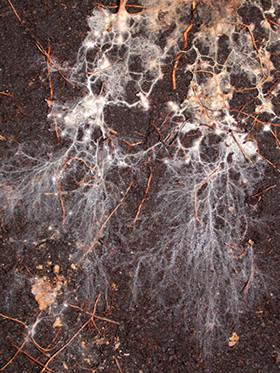Ok back hehe
Aaand it wasn't what you're proposing, it was your comment on the way I , er intervened, that is almost killing me.
I was just trying to be nice!!

Ok so to start at the top - we don't know enough about fungi and their functions in the soil to be doing anything even close to what your idea sparking the thread would require

Also, scientific evidence, when you look at the trend of findings obtained by sound methods, is pointing more and more clearly in the direction of diversity, mutualism, cooperation, and versatility. So to let you continue in this direction would be the same as watching that pal teetering aweay from the fire, purportedly heading for the creek, but leaving in direction of the shit pit instead - wrong way!!

To exemplify, there have been fungi found to be able to live happily as saprophytes, but switching to mycorrhizal mode when opportunity allows. Just as the plant enzymatically causes mycorrhizal spores to germinate and find their way to its roots, the fungi in turn groom their bacterial lackeys. Scientists have found the DNA of bacteria commonly found around those fungi in the fungi's DNA - up to 40% of it. WTF is that fungus going to do with that info? is it going to split off a part of itself to create the bacteria it needs for company?!?
We do not know.
But do you see how this all is not going in the direction of there being this set of specialists we can employ optimally to maximize our results?
Do you see the parallel to our highly fragmented, overspecialized world, where the hand does not know what the foot is doing, the greater overview is completely lost and we kneejerk our way through life?
It's an all-pervasive pattern. We breathe it like the air around us. And that's what makes it so challenging to be on the cutting edge, breaking through those patterns to adopt a different perspective. It's like the proverbial fish in water, not realizing it's in water because it's all it knows. We've seen it, just sometimes we don't have the whole picture

Oh and nothing I say is any form of ultimate truth, it's just the present stage of what I know and what can be deducted therefrom, humbly!
So, if I understand correctly, on the one hand you want to use the spent substrate from your mushroom cultures to improve your soils. And that "contaminated" in shroomland means trichos started growing on them.
But if I understood correctly again, you grow those mushrooms under sterile conditions?
So you need to pay attention to what you've done to get it that way, did you use salts, antibiotics, did you autoclave? Then the best place for them will be in your compost, getting diverse life back in there. And if the mycelium of the fungus that was properly growing there sticks around, all the better. Because as said, we know only, that a large diversity of aerobic beings in the soil, in the right fungal to bacterial ratio for the plants we want to grow, is a good thing.
I also got the impression that you want to see if the fungi you've been culturing would go mycorrhizal with the cannabis. While that's a really cool experiment, it's not going to be easy to determine.
To observe endomycorrhizal root colonization (cannabis doesn't do ectos, that much we know), you need to do some stuff with the root I haven't studied yet (bleaching and dying), and look at it under the microscope - a light microscope, with a condenser and iris diaphragm while you're at it, that digital one only lights from above, and those resolutions, while I do almost see the single cells when I go to look at my trichs, honestly, I don't get them

Now, to determine if the colonization you're seeing is actually the fungus you're going for, or rather (and likely) a combination of different ones all working alongside each other, I thinkk only DNA analysis can identify to that specificity

And what you've done with your clones is harmless, and hey yeah, maybe the cultures will take!

Sadly, after I moved, the edibles I had growing alongside my chili plant no longer showed up, I blame the dry air.
BUT also, that chili plant has always had problems with bug infestations - so maybe, that's just tooo fungal for it. Something to watch out for in case you do get the mushrooms to sprout fruiting bodies in there

Hoping that wasn't all that bad!
























